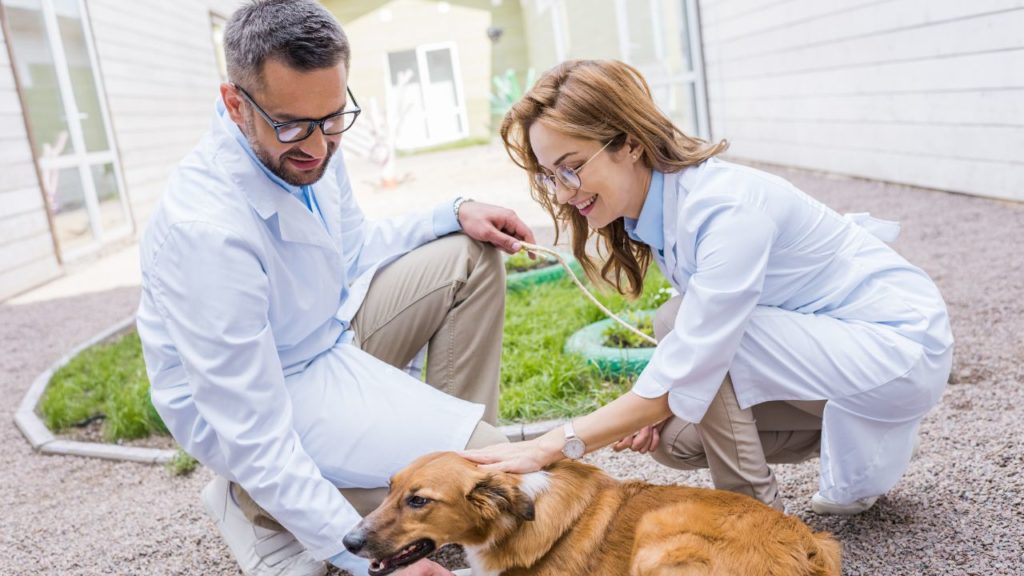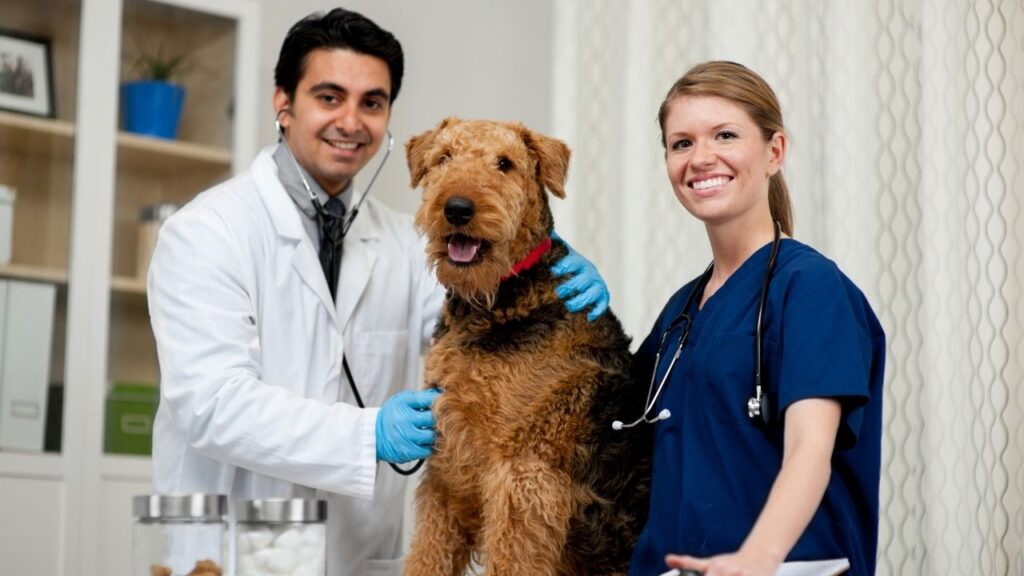Online veterinarians may not be able to prescribe medications or fully diagnose your dog, but they can be an invaluable resource for you if you live in a rural area, are in an emergency, or have a dog who gets stressed out at the vet hospital.
Key Takeaways
- Due to federal restrictions, veterinarians cannot prescribe medications for dogs they haven’t personally examined. But if your veterinarian has already examined your dog, they should be able to write prescriptions.
- Due to federal and state regulations, virtual vets often can’t prescribe medications like antibiotics. However, they can usually help you figure out whether you need to visit your veterinarian in person.
- Online vets working for reputable companies and/or out of their practices in states that allow telemedicine are licensed.
Why Use an Online Veterinarian?
In recent years we have seen how important remote and virtual access has been for human and veterinary medical care. Once considered impossible, we’ve now understand that online veterinarians might be a crucial part of good healthcare.
Telehealth, specifically telemedicine, has allowed dog lovers to communicate directly with veterinary health care providers from the comfort of their own homes when they might not have been able to previously.
Barriers to receiving veterinary care, such as long-distance travel, inability to access transportation, or having a pet who gets stressed during office visits or has mobility issues, can limit access to in-person veterinary care and harm a pet’s health.
Using an online veterinarian or telemedicine provides convenience to dog lovers so there are as few obstacles as possible to accessing their pet’s medical care. As a result, a closer relationship can be fostered with the veterinary team to make sure the animal is in the best health possible.1,2,3
The Legalese Behind Online Veterinarian Terms
With so many similar sounding words, it can be confusing to understand the differences between all the forms of remote and virtual veterinary medical communication. Many of these terms are regulated by federal, state, and local pet health, business, and licensing authorities, so you may hear various phrases depending upon your location.
Veterinary Telehealth
Telehealth is an umbrella term that includes all uses of technology to gather and deliver health information remotely. Telehealth is divided into several groups based on who delivers and receives the information and their relationship with one another.
Communication between veterinarians and pet owners is divided into two categories based on whether a veterinarian-client-patient relationship (VCPR) has been established.1,2 A VCPR is present when a veterinarian has assumed responsibility for making clinical judgments about an animal’s health, allowing them to diagnose and treat any medical conditions.
How do you know if you have a VCPR? For this relationship to exist, a veterinarian must examine your pet in person and be available for regular follow-up visits to monitor their health. 2,4
Additional information about the limitations of the VCPR will be included below.
Veterinary Telemedicine
Technically, telemedicine is the electronic communication of health information between the veterinarian and pet owner where a VCPR has been established.
Telemedicine can include a wide range of modalities including phone calls, texts, emails, Skype calls, or using a mobile app to communicate with your veterinarian.
Telemedicine is a tool that veterinarians and clients use with each other, not a separate category of veterinary medicine.
The use of telemedicine can enhance the relationship between pet owners and veterinarians as it allows for the sharing of information and pet owner questions in a more convenient and expedited way without an in-person appointment.
Veterinary Teleadvice
Teleadvice is a term used for a non-patient-specific service that can include health information, opinion, or guidance. In short, it is advice without first establishing a VCPR.
Both veterinarians and non-veterinarians can provide teleadvice by phone, text, or online. It is not intended to diagnose, treat, or prevent illness or injury.
In the veterinary community, we think teleadvice is most appropriately used to reinforce the importance of regular in-person veterinary visits and provide information about preventative care such as vaccines and flea, tick, and heartworm medications.
It is not intended to be a substitution for any in-person veterinary service.
Veterinary Teleconsulting
Teleconsulting is a term used for the (remote) communication between a general practice veterinarian and a qualified expert or veterinary specialist.
For example, in a specialty hospital, a general practitioner might be able to ask their Internist colleague for a quick inhouse consult, but in a smaller practice, that veterinarian might have to call, email, or videoconference with an Internist at another hospital. Any consult that doesn’t happen in person is called teleconsulting.
This is how general practitioners receive guidance and insight for the care of their patient. Typically, teleconsulting only involves veterinarians, but it can include the pet owner in a three-way communication so that all parties can share information directly to get on the same page regarding an animal’s care.
Dr. Rachel Venable is an oncologist who can conduct "live in person via video conference" consulting with you, your veterinarian, and your dog, right in your general practitioner's office. Learn more about this cutting edge online veterinarian on DOG CANCER ANSWERS.
Veterinary Telemonitoring
Telemonitoring is a term for the remote collection of health information that can include metrics such as temperature, heart rate, respiratory rate, ECG data, blood glucose levels, and more via wearable devices like harnesses.
Some telemonitoring devices are designed to provide access to health information by veterinarians outside the limitations of a short in-person visit while others are marketed directly to pet owners to obtain more information about their pet without the clinical input from a veterinarian.
Some of these devices are less than reliable, so the importance of data produced by telemonitoring devices should be determined after being analyzed by your pet’s veterinarian.5
Veterinary Teletriage
If you’ve ever called the veterinary hospital, described your dog’s symptoms, and received an assessment over the phone, you’ve engaged in teletriage.
Teletriage is electronically assessing an animal’s condition by a knowledgeable person to determine urgency and if immediate medical care is needed based on information provided by the pet owner. Most teletriage services are performed by a veterinarian or veterinary technician.
A diagnosis is not rendered during teletriage, but clients can be counseled on the next best course of action and whether their pet’s health issue needs to be addressed right away or if they can wait to be seen in person.1,2
The Benefits of Telemedicine and an Online Veterinarian
Telemedicine has many advantages for both veterinarians and pet owners, even though federal law requires a VCPR be established first (see more below). As the veterinary industry shifts toward being more online, hopefully, these benefits will increase.
Online Veterinarians are Convenient
Aside from finances, common obstacles to obtaining veterinary care can include difficulty getting to the veterinary clinic in terms of distance, scheduling, transportation, or disability.
Remote access (via phone or videoconference, and even text) to veterinary care can remove many of these deterrents resulting in a stronger relationship with the veterinarian and an improved ability to get follow-up appointments so the veterinarian can assess the pet’s progress.6
Online Veterinary Services are More Comfortable
One of the common complaints from dog lovers about having to see their veterinarian is the stress and anxiety their animal experiences while in the office.
Pets pick up on the smells and sounds of other animals which can compound the distress they may already feel while being in an unfamiliar place.
Additionally, as dogs age and develop mobility issues, getting them into the car and then walking them through the clinic that may have smooth, slippery floors can be dangerous and difficult.
Online veterinary services and telemedicine offer an excellent alternative where owners can take a video of their dog’s behavior or show their vet over a video appointment.
Online Veterinary Specialist Services
Where previously in-person appointments were the only way to access the expertise of board-certified veterinarians who may be located hours or multiple states away, telemedicine has allowed veterinarians and pet owners to converse directly with specialists anywhere in the world.
Additionally, virtual communication allows for the easy sharing of diagnostic results like bloodwork or pathology data, so the expert has them in hand during the visit.
Veterinarians might contact the expert on their own or they may set up a three-way video consultation appointment with the pet owner. In this way, pets can get the best care possible for many health issues that may develop.1,3
Dr. Lindsey Bullen is a nutritionist, a specialty that commonly works via telemedicine. Listen to her discuss her field in this episode of DOG CANCER ANSWERS.
Preventing the Spread of Infectious Diseases
Some easily transmissible illnesses, like kennel cough or parvovirus, can make other pets sick when they come into the veterinary office for treatment.
While there is no substitute for an in-person examination and diagnostics like radiographs, a veterinarian may be able to assess the severity of a patient’s illness or check their recovery via video consultation and reduce the number of infectious animals present in their waiting areas.
Quick Access to Reliable Information
One of the problems with universal internet access is the temptation to Google everything, from the possible causes for a pet’s health issue to instructions on how to care for a wound or manage acute vomiting or diarrhea. This happens to medical professionals, too. When your loved one is sick, you want a quick answer.
Telemedicine provides the benefit of ready access to the veterinarian’s medical team so dog lovers can get easy access to accurate and trustworthy information.7,8
Getting a consult with a veterinarian about CBD use is tricky in most states, but not all. Dr. Gary Richter talks about veterinary consulting for cannabis on DOG CANCER ANSWERS.
Easily Accessing Medical Records
Before telemedicine, a pet’s medical record was typically only kept in the veterinary office, with clients needing to request copies to read through their pet’s medical history.
Now, clinics that employ platforms that provide remote access to medical records allow pet parents to get ready access to those records if they have questions about what was performed or recommended by their veterinarian.
Online Veterinarians Can Often Do Surgical Rechecks Virtually
Recheck appointments are often scheduled 7-10 days after a surgical procedure to make sure the surgical site is healing well and the sutures have remained in place. It’s a quick appointment, but it can be stressful for the dog still feeling the surgery’s effects.
In one study, clients who were offered a videoconferencing service for surgical rechecks were equally satisfied with in-person exams with the added benefit that their dogs were more comfortable being assessed from home.9
Chronic Conditions and Hospice Care Are Ideal for Online Veterinarians
As they age, many pets may develop chronic health conditions like osteoarthritis or skin conditions that benefit from regular assessment by their veterinarian. However, the amount of time required for all of these extra visits may not be doable for all clients.
Additionally, office visits may not be doable for pets at the end of their lives, whose quality of life and comfort need to be regularly assessed. 3,10
Telemedicine allows for quick video appointments where the veterinarian can check in on an animal’s progress to determine if any changes need to be made to its treatment regimen.
Online Veterinary Relationships Are Popular
While some veterinarians may be concerned about the increased distance from their patients and clients with telemedicine, studies have shown that pet owners who take advantage of telehealth and telemedicine services actually have an almost uniformly positive experience.
Clients feel better informed about their pet’s illness and also better able to communicate their concerns with their regular veterinarian during in-person visits.8
Online Veterinary Telemedicine Tools
Depending on the needs of the dog lover and veterinarian, multiple modalities can be used for telemedicine including phone calls, app-based or web-based texting, email, video-based (Skype) conferencing, and smartphone apps that allow for shared patient records.
The communication timing between dog owner and veterinarian can be separated into categories based on whether it is performed in real-time (synchronous) or shared in an indirect manner (asynchronous). Each form has advantages and disadvantages and may be ideal for different situations.
Synchronous Communication
Live two-way video or audio between pet owner and veterinarian is an ideal way to have an in-depth interaction where there is an immediate and efficient transfer of information. Live communication where facial and vocal cues are available can help reduce the likelihood of miscommunication that might occur in a text-only format.
Some drawbacks of synchronous interactions may include poor lighting in a client’s home, a pet being uncooperative in demonstrating a concerning behavior, and interruptions from poor internet quality.
Additionally, synchronous interactions are less likely to be recorded in the veterinary clinic records making it difficult to remember precisely what was recommended or shared.2
Asynchronous Communication
Asynchronous communication involves any shared information that does not occur in real time and can include various things such as texts, emails, and recorded video messages.
Asynchronous methods can provide the benefits of reduced interruptions, better lighting, and recording of relevant behaviors and the transfer of large amounts of information that may take too long to communicate directly.
Disadvantages of asynchronous communication involve potential delays in response time after a message has been sent, miscommunications, and a feeling of detachment that may occur in the relationship with the veterinarian.2
The Limitations of Online Veterinarians and Telemedicine
Federal requirements, such as those from the FDA and USDA (along with the recommendation from the American Veterinary Medical Association), state that a physical examination must occur for a VCPR to exist but can be maintained through electronic means once already established.
Without the VCPR, a veterinarian cannot diagnose, treat, or prescribe medications. Even recommending over-the-counter medications breaks the law.4 The exception to this requirement would be in an emergency where life-saving medical care needs to be provided immediately.11
If you have ever felt frustrated because your veterinarian wanted you to come into the office before they wrote a prescription, this is why. They don’t want to risk their license.
However, confusion can result as different states may have VCPR laws that omit (leave out) the federal requirement for in-person examination for a legal veterinarian-client-patient relationship.
For example, the laws in states like Michigan and Virginia state that a VCPR can be established virtually. As a result, knowing what is and is not allowed in a particular area can be confusing.
Thus, most veterinarians abide by the more stringent federal requirements to ensure the relationship with their clients is appropriate and legal.1,4
Telemedicine and Online Veterinary Options for Dog Cancer
Specifically for dogs with cancer, telemedicine can provide significant benefits.
Pets undergoing chemotherapy or have cancers causing significant pain, like osteosarcoma, may benefit from assessments performed remotely to avoid the discomfort and disruption resulting from in-person visits.
While there is no substitute for the information obtained through a physical examination of your dog’s lesions, video conferencing or close-up photos can help inform your veterinarian about whether an in-person visit is needed.
As in human tele-oncology, video communication allows veterinarians to check in regularly with their patients, especially those with challenging cancers who must be followed closely.12
Telemedicine with an Oncologist
Services such as FiduVet allow veterinarians to access advice from board-certified veterinary oncologists anywhere in the United States. As a result, your pet’s veterinarian will receive recommendations for the ideal treatment protocols for your dog’s cancer and an interpretation of their diagnostic results.
The specialists can also provide information about prognostic factors and statistics about your pet’s particular form of cancer and resources that may help improve their quality of life throughout the treatment process. 13
How Much Does an Online Veterinarian Cost?
The cost of telemedicine services can vary greatly depending on who is providing it (direct from the clinic or through a service provider), what form of communication is involved (email vs. video conferencing), and the cost of the time required by the veterinarian to perform it.
Your veterinarian may use TeleVet14 or AirVet, which have several cost options from $30/month memberships to $49 on-demand video calls with no time limits.15
The cost of the same telemedicine service can differ between clinics, and clients may be charged in different ways, including per session or as part of a wellness plan or subscription bundle.
There is likely to be an increased cost if there is a specialist involved in your dog’s care as the veterinary clinic often has to pay extra to get access.16,17
Since costs are so variable, it is very difficult to determine the general cost of services. Telemedicine services where a VCPR is present can cost between $50-$250 compared to the cost of general advice telehealth services that do not require a VCPR, like AskVet offers a $9.99/month fee18 or Chewy, which offers a $14.99 chat session or $19.99 for a 20-minute video call.19,20
Since there are so many options, you should consult your veterinarian to determine which services may be best for you and your pet’s needs.
- AVMA-Veterinary-Telehealth-Guidelines.pdf. Accessed December 9, 2022. https://www.avma.org/sites/default/files/2021-01/AVMA-Veterinary-Telehealth-Guidelines.pdf
- Cox S, Dodd C, Evans B, et al. The AAHA/AVMA Telehealth Guidelines Task Force.
- The Real-Life Rewards of Virtual Care, AAHA. Accessed December 19, 2022. https://www.aaha.org/globalassets/05-pet-health-resources/virtual_care.pdf
- Federal requirements for the VCPR. Accessed December 19, 2022. https://www.avma.org/sites/default/files/2022-06/Federal-VCPR.pdf
- MeasureON! – Pet Health & Vitals Monitoring Device by VetMeasure. VetMeasure. Accessed December 19, 2022. https://vetmeasure.com/
- Smith SM, George Z, Duncan CG, Frey DM. Opportunities for Expanding Access to Veterinary Care: Lessons From COVID-19. Front Vet Sci. 2022;9:804794. doi:10.3389/fvets.2022.804794
- Telemedicine 101: Free Time and Peace of Mind – ACVC 2021 – VIN. Accessed December 19, 2022. https://www.vin.com/members/cms/project/defaultadv1.aspx?pid=27741&catId=&id=10485692&said=&meta=&authorid=&preview=
- Roca RY, McCarthy RJ. Impact of Telemedicine on the Traditional Veterinarian-Client-Patient Relationship. Top Companion Anim Med. 2019;37:100359. doi:10.1016/j.tcam.2019.100359
- Bishop GT, Evans BA, Kyle KL, Kogan LR. Owner satisfaction with use of videoconferencing for recheck examinations following routine surgical sterilization in dogs. J Am Vet Med Assoc. 2018;253(9):1151-1157. doi:10.2460/javma.253.9.1151
- Service models for veterinary telemedicine. American Veterinary Medical Association. Accessed December 19, 2022. https://www.avma.org/resources-tools/animal-health-and-welfare/telehealth-telemedicine-veterinary-practice/service-models-veterinary-telemedicine
- AAVSB RECOMMENDED GUIDELINES FOR THE APPROPRIATE USE OF TELEHEALTH TECHNOLOGIES. Accessed December 19, 2022. https://vvca.org/wp-content/uploads/2020/08/Guidelines-for-TelehealthAAVSB2020_4_10_min.pdf
- Shirke MM, Shaikh SA, Harky A. Tele-oncology in the COVID-19 Era: The Way Forward? Trends Cancer. 2020;6(7):547-549. doi:10.1016/j.trecan.2020.05.013
- SDTS. Oncology – Telemedicine Consultants for Veterinary Practices. Fidu. Accessed December 19, 2022. https://fiduvet.com/oncology/
- Televet: Practice Management Software for DVMs & Vet Clinics. TeleVet. Accessed December 19, 2022. https://televet.com
- How does Airvet work? Airvet. Accessed December 19, 2022. https://airvet.zendesk.com/hc/en-us/articles/360055349812-How-does-Airvet-work-
- Pricing models for veterinary telemedicine. American Veterinary Medical Association. Accessed December 19, 2022. https://www.avma.org/resources-tools/animal-health-and-welfare/telehealth-telemedicine-veterinary-practice/pricing-models-veterinary-telemedicine
- Veterinary Connected Care Companies. Accessed December 19, 2022. https://ebusiness.avma.org/files/coronavirus/AVMA-Connected-Care-Providers-List.pdf?_gl=1*19uttu9*_ga*ODk5MTU4OTAyLjE2NTQyODg0NDM.*_ga_L7SBEK6H36*MTY3MDY5NTQwMy4yMS4xLjE2NzA2OTYyMjIuMC4wLjA.
- AskVet: Pet Care & Vet App for Health and Wellness. AskVet. Accessed December 19, 2022. https://askvet.app/
- Chewy: Connect With a Vet. Accessed December 19, 2022. https://www.chewy.com/b/connect-vet-16616
- Best Online Vet [2022] | Consultations, prescriptions, and more. Accessed December 19, 2022. https://www.innerbody.com/online-vet-visits9
Topics
Did You Find This Helpful? Share It with Your Pack!
Use the buttons to share what you learned on social media, download a PDF, print this out, or email it to your veterinarian.









